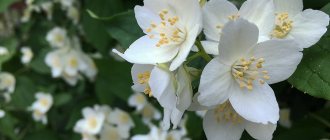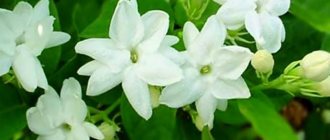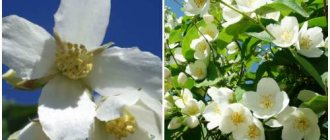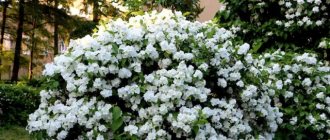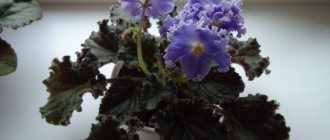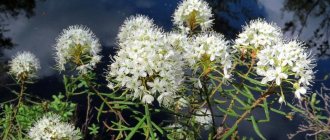Mock orange crown
When landscaping park areas and creating various plant compositions in personal plots, along with flowering plants, as a rule, various types of shrubs are planted. Various types of mock orange, a deciduous multi-stemmed shrub that blooms in early summer, have gained particular popularity among domestic gardeners. Among the representatives of the Hydrangeaceae family, the most common is the crowned mock orange, which is distinguished during flowering by very attractive snow-white or cream flowers with an extraordinary aroma. Despite its popularity, many lovers, due to the similarity of the inflorescences and pleasant smell, mistakenly call it garden jasmine - an evergreen shrub belonging to the Olive family, which is fundamentally wrong.
small-leaved
A crop with small leaves on thin stems and fragrant, inconspicuous flowers. During flowering it emits a strawberry aroma.
Chubushnik Blizzard
It is distinguished by fluffy inflorescences of snow-white flowers consisting of elongated petals. Buds up to 7 cm in size are collected in inflorescences of 5-7 pieces. During the flowering period, the bush resembles an avalanche.
What does mock orange look like? Snowstorm
Minnesota Snowflake
The mock orange variety is a low-growing shrub up to 60 cm. The plant is often used in group plantings to create a hedge effect. The flowers are collected in inflorescences at the tips of the branches, the buds are small and double. The bush needs to be thinned every 2 years to improve flowering. Without pruning, the height of the plant can reach 2 meters.
It is important to know! All plant varieties require preventive pruning. Removing old and diseased shoots improves the flowering of the bush and serves as a disease prevention
Chubushnik Chamomile
So called for the similarity of the flower to the bud of a field plant. It blooms at the end of summer, the size of the bush is small - up to 1 meter. The leaves are small and narrow. The culture loves bright sun, but does not suffer in the shade. Do not allow water to stagnate in the roots. The tree grows best in fertile acidic soils. The variety can withstand harsh winters; young shoots freeze slightly, but the bush quickly recovers.
Mock orange crown - description of the species
The mock orange plant (Philadelphus coronarius) is a deciduous shrub, reaching a height of up to 3 m and up to 1.5-2 m in diameter, with oblong, oppositely arranged leaves. During the flowering period, delicate flowers, creamy white in color, collected in racemes, exude a fragrant, rich aroma.
Under natural conditions, it is more often found in the south of Western Europe and the Caucasus. Since the 16th century, breeders have developed forms specifically designed for landscaping gardens and parks located in temperate climate zones. In the 18th century, specialists from the St. Petersburg Botanical Garden began a detailed study and description of the characteristics of Philadelphus species, starting with the most common mock orange coronata. Since that time, a sufficient number of varieties have been cultivated that are successfully grown not only in domestic gardens and parks, but throughout the globe.
It is especially valued by gardeners not only for its decorative qualities, but also due to its adaptability to the conditions of central Russia and its low maintenance requirements. Philadelphus coronarius is quite frost-resistant - down to -25ºC; in stronger frosts, the branches freeze to the level of the snow cover, but in the spring young shoots quickly grow and the plant recovers.
Annual abundant flowering, lasting up to 3 weeks, begins at the age of 5 and lasts up to 30 years.
A long-lived shrub (life cycle up to 80 years), well adapted to the air pollution conditions of large cities. Widely used in both single and group plantings, when creating landscape compositions, green hedges or borders formed by pruning.
Plant care procedure
Mock orange does not require close attention, but the necessary conditions should be observed:
- Every year, slurry is used as top dressing. The use of mineral fertilizers begins in the second year. Before flowering, a solution is prepared for 2 bushes: 15 grams of urea, 30 grams of superphosphate and 15 grams of potassium sulfate are added to 10 liters of water. After flowering - mixture per 1 sq. m of territory: 20 grams of superphosphate, 15 grams of potassium sulfate and 150 grams of wood ash.
- Watering is carried out in moderate amounts. After planting, 10-20 liters of water are poured under each bush. During the year, moisture is added as needed, but not more than 30 liters at a time under the bush. Humidification is carried out after sunset.
- Before planting, the branches of the seedling are cut off. Only 2 buds are left. Every year, branches are regularly pruned after flowering and before growth begins. Weak and dying shoots are also removed. If sanitary pruning is required, then up to 25% of the bush is cut out.
Planting and proper care
Despite the general undemandingness and ease of care of this species, in order for the plant to become a real decoration of your garden, it is recommended to create the most favorable conditions for its growth and development. The developed basic recommendations will provide practical assistance in organizing proper care for the crowned mock orange:
Considering the durability and size of an adult shrub, the choice of planting site must be approached in advance and carefully. Mock orange grows equally effectively both in open space and in partial shade, but the quality and duration of the flowering period directly depend on the lighting - in sunny areas the bush blooms longer and the inflorescences are larger;
In general, the plant is not picky about soil; the only limitation is that it does not tolerate soil salinity and wetlands. In heavy clay areas, it is advisable to arrange drainage. It is capable of fully demonstrating all its decorative qualities on almost any cultivated soil, so before planting it is recommended to improve the soil with organic matter or compost.
It takes root equally effectively both during spring and autumn planting. The roots of the seedling are placed in a small hole (depth and diameter up to 50 cm) up to the root collar and covered with fertilized soil. The soil around the planted shrub is compacted and then watered abundantly;
After planting, regardless of the time of year, it is necessary to shorten the main branches by a third and completely cut off weak shoots. Subsequently, annual pruning is carried out after the end of the flowering period. Underdeveloped branches are cut out and at the same time a bush-like crown is formed. If the bush is frozen in winter, it is necessary to carry out sanitary pruning in early spring;
In the first year after planting, the plant needs regular watering, and subsequently - as needed, depending on weather conditions. It is advisable to apply fertilizing or mineral fertilizers twice a year - in early spring and after flowering. You can apply complex mineral fertilizers diluted with water with irrigation; if organic matter is present, prepare slurry and water with a solution diluted with water in a ratio of 1 to 10.
Thus, the crown mock orange, being an unpretentious ornamental shrub, only needs timely thinning, periodic watering and removal of weeds from the tree trunk space. Planting and care are quite simple, do not require excessive effort or a lot of time, and propagation will not cause much trouble either.
Growing Tips
In order for the mock orange to delight you with large flowers, becoming more lush and beautiful every year, below are the main conclusions that everyone who plans to grow a bush on their site needs to remember:
- for planting, you should choose a semi-shaded place, but with sufficient light, without direct sunlight on the leaves throughout the day;
- deepen the root collar into the soil no more than 3 cm;
- perform formative pruning every fall to obtain young growth in the spring;
- once every 2-3 years, do sanitary pruning to remove old branches that take away the vitality of new ones;
- do mineral and organic fertilizing twice a year - before and after flowering;
- take time to loosen the soil in the hot months;
- in June–July, during the drought period, water abundantly with 20–30 liters of water under each bush;
- remove weeds weekly during the summer months;
- Maintain moderate soil moisture and periodically spray.
The uniquely beautiful perennial and lushly flowering mock orange bush is especially attractive in the guise of the Variegatus variety, which is distinguished by a fabulous combination of cream flowers and white-edged leaves. This is the king of garden shrubs with an inviting aroma that is easy to care for, making the plant attractive to gardeners of all experience levels.
How to propagate mock orange
Ornamental shrubs can be propagated by two methods: generative, that is, seeds (germination rate 100%) and vegetative - by dividing an adult bush, green cuttings or layering. All of the above methods are equally effective and are accessible even to novice gardeners.
Seeds are sown in late autumn (no need for preliminary stratification), before the onset of stable frosts, in a specially prepared bed. In case of a winter with little snow, it is recommended to cover the bed with spruce branches. As a rule, friendly shoots appear in the spring, which will grow in the same bed until autumn and reach a height of 20-25 cm. Spring sowing is also allowed, but only in greenhouses or unheated greenhouses.
In the fall, lignified cuttings are cut from an adult bush of the variety you like, sprinkled with damp sand and stored in the basement. In the spring, after the cessation of night frosts, the cuttings are planted in a sandy loam substrate at an angle of approximately 45 degrees, deepening up to the top 2 buds. After 30-35 days, the planted cuttings will develop a completely viable root system. Growing cuttings need regular watering and periodic loosening of the soil. Summer (green) cuttings are also possible, which is carried out in the second half of June, but it is advisable to carry out rooting in greenhouses.
For this purpose, young shoots are removed in the spring, after loosening and leveling the soil near the trunk. Layers are pressed to the ground with wire or wooden brackets. The branches fixed in this way are placed in small prepared grooves and covered with a mixture of soil, sand and peat. The emerging young shoots are regularly watered and hilled. In mid-autumn, cuttings can be dug up and divided into individual plants with their own roots.
Reproduction methods
Video about mock orange Shneeshturm reports that the shrub can be propagated in several vegetative ways. When using any of them, jasmine takes root well and quickly begins to delight with abundant flowering.
Cuttings
The easiest way to increase the mock orange population on a site is with the help of green cuttings. The algorithm looks like this:
- In June, several young shoots up to 5 cm long are cut from an adult bush.
- Four leaves and an internode are left on each cutting.
- The top two plates are cut in half, and the bottom ones are removed.
- Treat the sections with a stimulating solution.
- The cuttings are planted in a temporary place in nutrient soil and covered with plastic bottles.
After the shoots begin to grow, they can be transferred to a permanent site.
It takes about a month for mock orange shoots to take root with regular watering.
Layerings
A simple way to propagate mock orange is to use flexible layering. The diagram looks like this:
- Last year's shoots are bent down and placed in shallow grooves.
- The branches are fixed and sprinkled with nutritious soil, leaving the tops above the surface.
- During the summer, the cuttings are watered abundantly.
With the onset of autumn, rooted shoots can be separated from the main bush.
In order for the layering to give roots faster, mock orange shoots can be slightly cut in the recessed part
The most common forms and varieties
In the process of long-term cultivation, starting from the mid-16th century, breeders developed a significant number of garden forms of crown mock orange, distinguished by their decorative qualities.
In landscape design, domestic gardeners often use the following varieties:
"Aureus" - characterized by a spherical crown and foliage color. In spring, the leaves are painted bright yellow, turn green over time and do not change color again until they fall in the fall. Despite the fact that the background of the leaves is smoothed out by the flowers themselves and they are not so expressive, the shrub has a spectacular appearance throughout the entire season;
"Innocence" is a compact shrub with dark green leaves with fancy creamy-yellow streaks. During the flowering period, white delicate flowers exude a very strong but pleasant aroma. Valued by gardeners for the decorative color of the leaves and the incomparable delicate aroma of flowers, it is often planted near buildings or garden gazebos;
"Variegatus" is a dense, rounded bush, slightly lower than its counterparts (1.5-1.7 m), distinguished by dark green foliage with white edges. Mock orange "Variegata" is preferably planted on fertile soils in sunny or partial shade. More often used in landscape compositions as a small flowering variegated element. Winter hardiness of "Variegata" is slightly lower in comparison with other varieties;
“Duplex” – differs in shape and size. The height of an adult plant does not exceed 1 m, while the diameter of the dense crown reaches 1.7 m. Due to its compactness, it is grown in small gardens or in park compositions. During the flowering period, white double flowers look especially attractive against the background of rich green leaves.
Combining such important qualities as winter hardiness, decorativeness, ease of care, combined with a unique aroma during the flowering period, crown mock orange has ensured its continued popularity among gardeners. And it doesn’t matter that, due to the similarity of aromas, it is sometimes called garden jasmine, the main thing is to choose the variety you like, plant it in your garden and enjoy its beauty.
Botanical description of Jasmine Variegatus
The time has come to dispel the popular misconception and present the bush in its true form, because the plant is mistakenly called jasmine for its small, pleasant-smelling flowers. In fact, the variety Variegatus belongs to mock orange, a genus of shrubs from the Hydrangeaceae family and has nothing to do with jasmine.
But, since this name has become a household name, the article continues the tradition of this naming. The species belongs to deciduous or partially deciduous plants with thin gray bark.
Find out also what is the difference between mock orange and jasmine.
The bush forms a dense crown up to 2 m high. Small flowers are painted white or cream, reaching 3 cm in diameter. They are formed on inflorescences in the form of a brush, numbering from 3 to 9 pieces on each. The corolla consists of 4–6 rounded petals, and the fruit box contains up to 10 thousand small seeds. The flowering season falls in June–July.
The leaves of the variety are irregularly shaped, 7–9 cm long, dark green with a white edge (some of them are completely white).
Mock orange crown - a fresh look at the classics of garden design
The aroma and delicate beauty of mock orange, sometimes called garden jasmine, have made it a traditional decoration of gardens and parks for a long time. At one time, it began to get lost among the many new species of shrubs that appeared and were offered to gardeners. But in recent years, the mock orange has gained a second youth, many different forms of the plant have appeared, and the time has come for its renaissance.
Diseases and pests
The Schneeshturm variety of garden jasmine is rarely affected by fungi and parasites. The main danger for him is:
- powdery mildew - the fungus can be recognized by a whitish coating on the leaves;
For powdery mildew, mock orange is sprayed with copper sulfate or Fundazol - aphid - the pest feeds on the sap of the plates, deforms them and impairs flowering;
Tobacco infusion or the drug Karbofos are good against aphids. - spider mite - a parasite that settles on mock orange in hot, dry weather and leaves a thin web and light spots on the leaves.
It is necessary to fight spider mites with Fitoverm or Akarin solutions
To prevent fungi and pests, you need to regularly thin out the bush and prevent the accumulation of plant debris at the roots. It is also necessary to combat waterlogging of the soil and loosen it.
general characteristics
The genus Chubushnik includes about 60 species, of which the most widespread in our country is the crowned or common Chubushnik. The botanical description of the plant indicates that the height of this shrub can reach 3 m, and a characteristic feature of its old stems is cracking and partial peeling of the bark. The core is hexagonal in cut, wide.
Interesting fact! For this reason, in ancient times, the hollow wood of the plant was often used to make smoking pipes and chibouks. This is where the Russian name of the genus, “chubushnik”, comes from.
Another important feature, noted already in the Latin generic name of the plant Philadelphus (loosely translated as “brotherly love”), indicates the close proximity of opposite shoots.
The leaves located opposite each other on short petioles have a characteristic, memorable shape: a long pointed tip and a wide rounded base.
The flowers are white, cream or slightly yellowish in color, collected in medium-sized, loose clusters. Long lasting, about a month flowering begins at the end of May or June. After flowering, fruits are set, tetrahedral capsules with many seeds attached to short branches. The seeds ripen in July or August.
7sotok.by
The content of the article:
1.Features of the plant.
- Chubushnik and its historical roots.
2. The main types of garden mock orange.
3. Planting mock orange.
4. Reproduction of mock orange.
5. Care of mock orange.
6. Pests of mock orange.
Mock orange (garden jasmine) is a beautiful tall shrub with spreading branches, from which it is impossible to take your eyes off. The shrub is distinguished by a large number of varieties and species. The most basic and common types of garden jasmine include: lemoine, crown, terry. In order for a fragrant-sweet shrub with rich colors to please the eye, it must be planted correctly, carefully cared for, and know the peculiarities of reproduction.
Features of Plants.
Garden jasmine stands out among the diversity of all plants with its individual structure. The stem of the fragrant shrub has a brown-brown color, the bark is cracked, the height of jasmine reaches 4 meters. In spring, the color of garden jasmine leaves is characterized by a pale green hue; in autumn, the leaves transform into a bright lime color. The leaf size of the plant is quite large.
The flowers of this colorful shrub have a size not exceeding 5 cm in diameter, grow in a brush-shaped inflorescence, and stand out in creamy white shades. The flowering time of garden jasmine depends on its type, but the flowering period of most plants falls at the end of spring and lasts until mid-summer.
Chubushnik and its historical roots:
They knew about the mock orange bush in ancient times. The origins of its name come from Ancient Greece, in which a craftsman made “chubs” for a smoking pipe from the lower stem of the plant.
Sometimes mock orange is called jasmine. This is due to the similarity of the aroma notes and the inflorescence itself of these two extraordinary plants. A distinctive feature lies in the growing conditions. Jasmine is mostly grown indoors, while mock orange is grown outdoors in the garden.
The main types of garden mock orange.
Garden mock orange pleases gardeners with a huge selection of varieties and species. The most popular and unpretentious types of shrubs include: lemoine mock orange, coronal mock orange, terry mock orange.
Mock orange Lemoine.
The diameter of the crown of the Lemoine mock orange bush is 1.7 m, the maximum height is 1.5 m. The flowers are characterized by a fairly large size (up to 4 cm, 3-7 flowers on a brush), a rich sweet aroma, shades of white and light beige flowers. The total flowering period is three weeks, beginning to bloom in June and ending in July.
Lemoine foliage is ovoid in shape. The variation in leaf size is 4-5 cm. In spring and summer, the leaves of jasmine-lemoine are colored dark green, in autumn – golden yellow. Growth rates are characterized by an annual increase in width and height of 3-5 cm. The maximum peak age of garden lemoine is reached at 25 years.
This type of mock orange is practically unpretentious in choosing the soil in which it is planted, but the exception is saline and very wet soil. The plant loves to bathe in sunlight. If you plant it in a shaded place, this will affect the flowering level for the worse. In humidity it prefers regularity.
It tolerates winter quite well and is characterized by frost resistance. During a harsh winter, the shoots may freeze, but will quickly recover. Lemoine mock orange is planted in a well-lit place, the distance between the bushes should be 0.5-1.5 m, the planting depth is 50-60 cm (the root neck should be deepened no more than 2-3 cm, so as not to rot).
The mock orange root system holds the soil well and tolerates replanting quite favorably. Before planting, drainage is made with a 15 cm layer of sand and crushed stone. Soil mixture ratio: (2:3:1) humus, leaf soil, sand.
During care, it is worth systematically removing 4-5 old shoots. Sanitary pruning and thinning of shrubs is carried out after flowering of the lemoine. It is worth carrying out 2-3 feedings throughout the season. It is stable in urban conditions. It is often planted on the lawn in the form of decorative compositions (hedges, trimmed borders).
Chubushnik Crowned.
The diameter of the crown of this type of jasmine is 2 m, the maximum height is 3 m. The flowers are characterized by a fairly average size (up to 3 cm, 5-9 flowers on a brush), a rich honey-sweet aroma, shades of white and cream color. The total flowering period is 1.5 weeks, it begins to bloom in July and ends in August.
The foliage of mock orange is characterized by a sharp-oval shape. Leaf sizes range from 4.5 to 9 cm. In spring and summer, jasmine leaves are painted matte dark green, and in autumn – bright yellow. Growth indicators are characterized by an annual increase in width of 20-25 cm, height of 30-40 cm. The maximum age of the crown mock orange is 20 years.
This type of shrub is not picky in choosing soil, but the exception is soil that is oversaturated with moisture. Mock orange loves light very much. Planting in a shaded area will result in poor flowering. Prefers regular moisture and a place protected from the winds.
It tolerates winter well and is characterized by a high level of frost resistance. Crown mock orange is planted in a lighted place, the distance between the bushes is 0.7-2 m, the depth for planting is 55-60 cm. Before planting, drainage is prepared from sand and crushed stone. Soil mixture: (2:3:1) humus, earth, sand. Doesn't get fussy when transplanting. Thinning and pruning of the bush is carried out after flowering. Feeding is carried out in March-April. Basically, mock orange is planted to decorate a garden plot.
Chubushnik Terry.
The diameter of the crown of the bush is 1.3 m, the maximum height is 3 m. The flowers are medium in size (up to 4.5 cm, dense clusters, 5-10 flowers each), there is a light aroma of ordinary jasmine, the color is predominantly white-cream. The total flowering period is 3.5 weeks, it begins to bloom in early June and ends at the end of July.
The foliage of the terry mock orange has an ovoid, serrated shape. The leaf size is 5 cm. The leaves of the shrub are painted bright green, and yellow in autumn. Growth rates increase every year in width and height by an average of 5 cm. The maximum age is reached at 25 years. This type of mock orange is practically unpretentious in the choice of soil, with the exception of high soil moisture. The plant loves light. Planting in the shade is not recommended as this will reduce the flowering rate.
It tolerates winter with complications and is characterized by high sensitivity to frost (the small shrub wraps itself up). Terry mock orange is planted in a lighted place, the distance between bushes is 0.5-1.7 cm, planting depth is 50 cm. Drainage for this type of jasmine is made of sand and crushed stone. Care involves regular pruning and thinning. Feeding is carried out several times a season. Used in decorating garden plots.
Garden jasmine has a large number of other species. It is worth paying attention to a detailed consideration of planting, care, and propagation of mock orange.
Landing.
Initially, you should select a site for planting. If the place is shaded, then the flowers of the shrub will be small, and the shoots will grow very tall. An open, well-lit place would be great. If the soil permeability level is low, it is worth making drainage at the planting site (mix sand and crushed stone).
The optimal composition for planting garden mock orange is the ratio of leaf soil, sand, humus (3:2:1). The most favorable time of year for planting mock orange is autumn (mid-September - mid-October). In spring, jasmine can also be planted, but this should be done before the buds on the trees open.
When planting several mock orange bushes at the same time, the distance of the holes should be from 50 to 100 cm, taking into account the size of an adult bush. If the purpose of planting mock orange is to acquire a “fence-plant”, then when planting the seedlings have a distance of 50-70 cm from each other. The root system is immersed in the prepared hole so that the neck of the root is level with the surface of the area. Next, the root hole is filled with fertile soil.
Reproduction.
There are four ways to propagate mock orange: shoots, cuttings, dividing the bush, and seeds.
Reproduction of mock orange using shoots. In spring or autumn, shoots are cut from the bush and placed in moist soil until the root system forms. Next, the place where the sprouted shoots are planted is determined in accordance with the planting rules.
Propagation of mock orange by cuttings. The young branch is torn off with a sharp movement from the main shoot. It should have a small piece of bark wood. To root the cutting you need drainage, peat, sand, a cap and a container. One-year or two-year cuttings no higher than 50 cm are selected. A drainage layer is placed on the bottom of the container, and moistened sand and peat are placed on top of the drainage. The next layer is 2.5 cm of sand, which is watered with a fungicidal solution. The cuttings are planted at an angle of 35 degrees and covered with a previously prepared cap. To speed up growth, the cuttings are sprayed with water daily.
Reproduction of mock orange by dividing the bush. It is the fastest way to grow a plant. The most optimal period for this type of propagation of garden jasmine is autumn (October). If the procedure is carried out in the summer, then it should be done before the plant blooms or after (except during flowering).
First, carefully dig up the bush so as not to damage the root system. Next, using garden scissors, the bush and roots are carefully divided into several bushes, which are planted in soil prepared according to all planting rules. For rapid development and strengthening of the root system, the plant should be planted in a well-lit place.
Propagation of garden mock orange by seeds. A type of reproduction that occurs in early spring. Before this, a greenhouse or greenhouse is built, containers with a nutritious mixture of peat, sand, and humus. To speed up germination, mock orange seeds are placed in a nylon bag and immersed in water at room temperature for 2 hours.
Next, for swelling, the bags are placed in sawdust or wet peat for 2 days. Then they are dried and laid out on paper, mixed with sand and sown in prepared grooves. At the end, the soil surface is crushed with peat. After strengthening the shoots, they are planted from the greenhouse into open ground.
Care.
Garden mock orange is an unpretentious plant. But despite this, every plant needs care and attention. The care procedure is not complicated. For an adult bush, the lion's share of care is carried out in early spring, until it completely emerges from winter dormancy. The soil around the root system is loosened and sprinkled with peat and humus.
For all types of garden jasmine, pruning is very useful (in place of old branches, young and healthy ones are formed). Using pruning shears or garden shears, very tall, old branches are trimmed at the very bottom of the bush (which, if not removed, will spoil the shape and aesthetic appearance of the plant).
In summer, the procedure for caring for flowering mock orange consists of watering. Since almost all types of garden mock orange are frost-resistant, they do not require special care in winter. The exception is a few species that need to be slightly wrapped in special material. It is necessary to carry out timely weeding.
A good fertilizer for garden jasmine is a mixture of water and manure (10:1 ratio). After the bush fades, it is fed with wood ash. If the plant is planted correctly and carefully cared for, it will delight the eye with light-saturated colors of flowers and a delicate aroma.
Pests.
Weevils, aphids, and spider mites are among the main pests of garden jasmine. Weevils and their larvae feed on the juice from mock orange leaves. If the summer is rainy enough, then aphids may appear on the tops of a young bush, which will harm growth. Often jasmine branches are covered in spider mites. To avoid troubles with these pests, the plant should be treated with a karbofos solution.
If individual branches are damaged, the mock orange can be saved by washing with a mixture of water and laundry soap. You can protect the plant from spider mites and aphids using burdock infusion (2 kg of burdock are poured into 10 liters of water, infused for 10 hours, filtered). Damaged mock orange is treated three times every 5 days. An infusion of mustard helps against weevils (100 g of dry mustard, pour 10 liters of water, let it brew for 48 hours). The plant is treated three times every three days.
Some representatives of mock orange
Although the classic form of mock orange is beautiful and quite attractive, man’s eternal desire for novelty has not bypassed his favorite shrub. Currently, many varieties and hybrids of mock orange are known.
Duplex
This compact, elegant plant is ideal for growing in small gardens or open areas of gardens and parks. The height of the bushes of the mock orange variety Duplex rarely exceeds 1 meter, and its dense crown can extend to a width of up to 1.7 m.
The semi-double flowers of this plant look delightful and delicate. At the same time, the shrub is completely unpretentious, it thrives in partial shade and in the sun, is not afraid of frost, and is not too picky about the moisture content in the soil.
Aureus
This is perhaps one of the most unusual representatives of the crowned mock orange. Looking at the photo, you can’t immediately guess what kind of plant is in front of us. When breeding it, breeders paid more attention to the decorativeness of the leaves rather than the flowers. The foliage of this variety of mock orange is bright yellow from spring and throughout the summer. Therefore, it is also called golden mock orange. And closer to autumn, on the contrary, it turns green, becoming greenish-yellow.
Solar brightness of golden mock orange
The flowers of the mock orange variety Aureus have a typical shape and are not too noticeable against the background of bright foliage; they have a strong, memorable aroma. The maximum height this shrub can reach is 2 m, but you will have to wait a long time, since this variety belongs to the category of slow-growing ones.
Variegatus
The special tenderness of mock orange Variegatus lies in the combination of leaves that have an unusual color and shape with a cloud of lush flowers. Indeed, the muted green color of the leaves, framed by a wide, uneven border, creates the impression of airiness. Their slightly irregular shape enhances the impression. And the finishing touch to the image of a delicate cloud is completed by white flowers with a slight yellowness in the center, which seem especially fluffy due to the abundance of long stamens. The usual height of mock orange Variegatus bushes is a little more than 2 m, some specimens reach 3 m.
What are the mistakes when growing
Even mock orange Variegatus is not immune from illnesses, and just like any plant, it can be susceptible to diseases. Most often, they are caused by weakened immunity - the result of improper care or unsuitable conditions for the bush. To avoid problems in the process of growing healthy and lushly blooming jasmine, you should remember about spring feeding, sanitary pruning and preventive treatment with insecticides.
Important! Jasmine Variegatus can become a victim of an attack by spider mites, aphids, and weevils. In this case, treatment with one of the above drugs together with insecticides (Aktara, Aktofit, Provado) is used.
Signs of errors in care may include:
- Drying of shoots. The complication is the alkalization of the soil due to watering with hard water. Try to stand it before use or “re-lay” the used substrate.
- Yellowing of leaf tips. The disease is hidden in a lack of moisture in the soil and air. The problem can be corrected by abundant watering or sprinkling to maintain optimal humidity levels.
- Leaves curl, dry out and fall off. The cause may be insufficient watering, dry air, or high temperatures. To solve the problem in the hot season, you need to water and spray more often.
- Brown spots on foliage and inflorescences. The likely cause is direct sunlight that burns the foliage. The area should be shaded with tall or climbing plants. It is better to immediately transplant young bushes to another place.
- Lack of flowering. This situation can occur due to a lack of light and the plant being in complete shade. Also, the bush does not bloom due to irregular pruning and depletion of the soil. Apply mineral fertilizers and transplant the jasmine to an area with sufficient sun.
- Dropping leaves. This happens when the root collar is deepened. It is necessary to remove the top layer of “excess” soil (it is recommended to do this in the spring).
- The appearance of a white coating on the greenery. This disease indicates infection with gray rot. Diseased branches are removed, and healthy ones are treated with fungicides (Trichodermin, Horus, Fundazol, Fitoverm).
Cultivation Secrets
Mock orange is one of the most unpretentious and easy to grow plants. Perhaps this is one of the reasons for such a wide distribution of mock orange in our gardens and parks. Most of its varieties grow well in both sun and partial shade. Mock orange also tolerates the frosty season well. Even if the branches freeze in the harsh winter, new shoots of restoration will emerge from the powerful root system in the spring.
Where to begin?
A sufficiently lit place is most suitable for planting mock orange. It tolerates slight shading well and grows even in the shade, but in such conditions the shoots of the plant become too elongated and flowering will not be abundant. Also, when choosing a place for planting, you should take into account that crown mock orange has a negative attitude towards the proximity of groundwater and stagnation of moisture in the soil.
Planting of seedlings can be done both in the fall, after leaf fall, and in the spring, before the leaves bloom. The depth and width of the planting hole should be at least half a meter, and to cover the root system, it is necessary to stock up on fertile soil or humus: the plant should be provided with soil nutrition for many years of its life.
For a single planted shrub, sufficient free space should be provided. There should be at least one and a half meters of free space around it. When planting plants in a row, in the form of a hedge, you must maintain an interval between bushes of 0.5 m to a meter.
First, drainage is placed at the bottom of the planting hole, then the seedling, spreading the roots evenly in the hole. Then the root system is sprinkled with fertile soil and the soil is well compacted. It is permissible to deepen the root collar by 2-3 cm, but no more, to avoid rotting. Planting is completed by abundant watering and mulching of the tree trunk circle.
How to care?
Caring for mock orange is not difficult. The most important thing for him is maintaining the water regime. As already mentioned, the plant does not tolerate stagnation of water, but it is also sensitive to its lack. Therefore, regular watering should be an important part of caring for mock orange. To ensure that moisture is used evenly, it is advisable to cover the tree trunk circle with a layer of mulch.
Good to know! It is great if compost is used as a mulching material, so the plant will be additionally supplied with organic substances.
In the year of planting, young bushes are not fed, so they take root better. In subsequent years, nitrogen fertilizers are applied at the beginning of the growing season, and phosphorus and potassium fertilizers are applied after flowering.
Corona mock orange bushes do not need systematic pruning: the plant is able to regulate its crown itself, taking on the correct beautiful shape. You just need to trim off the tips of the branches that have faded. This achieves greater decorativeness of the shrub in the summer, and the plant does not waste energy on the formation of fruits and seeds, directing more energy to the formation of flower buds and the development of leaf apparatus. Also, on the eve of winter, it is necessary to remove the unripe parts of the shoots: they will most likely die off in the winter. It is necessary to thin out and rejuvenate bushes that have been growing for a long time, in which the bush has become irregular in shape and some branches have become bare.
Application in landscape design
The terry variety of mock orange Schneeshturm is used for several purposes:
- for forming a hedge;
Thick mock orange hides the area well from prying eyes - for decorating facades and fences;
White Shneeshturm bushes look impressive under the walls of buildings - to create compositions.
The rapidly growing Schneeshturm tolerates shaping and artistic pruning well.
You can combine an ornamental shrub with lilac, hydrangea or tall roses. It is better not to plant the Schneeshturm mock orange variety next to fruit plants; it will suppress their development.
